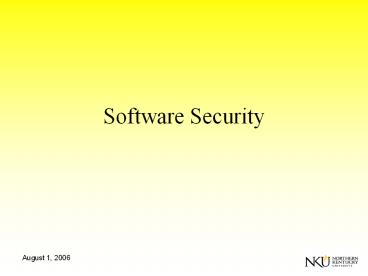Software Security - PowerPoint PPT Presentation
1 / 22
Title:
Software Security
Description:
Cryptography will not make you secure. Application firewalls will not make ... Joel Scambray, Mike Shema, and Caleb Sima, Hacking Web Applications Exposed, 2nd ... – PowerPoint PPT presentation
Number of Views:143
Avg rating:3.0/5.0
Title: Software Security
1
Software Security
2
Essential Facts
- Software Security ! Security Features
- Cryptography will not make you secure.
- Application firewalls will not make you secure.
- 50/50 Architecture/Implementation Problems
- An Emergent Property of Software
- Like Usability or Reliability
- Not a Feature
3
Security Problems
- SECURITY BUGS
- 50
- Buffer overflow
- Cross-site scripting
- Race condition
- SQL injection
- Unsafe system calls
- Untrusted input
- ARCHITECTURAL FLAWS
- 50
- Cryptography misuse
- Fragility
- Insecure auditing
- Lack of compartmentalization
- More privilege than necessary
- Replay attacks
4
Security as Risk Management
- Helps communicate security need to customer.
- Cost of security vs. amount of potential losses.
- No system is 100 secure.
- Some risks arent cost effective to mitigate.
- Humans make mistakes.
- New types of vulnerabilities are discovered.
5
Risk Management
- What assets are you trying to protect?
- What are the risks to those assets?
- Which risks do we need to mitigate?
- What security measures would mitigate those
risks? - Which of those measures is most effective, when
considering cost, side effects, etc.?
6
Software Security Practices
7
Software Security Practices
- Code reviews
- Architectural risk analysis
- Penetration testing
- Security testing
- Abuse cases
- Security operations
8
Code Reviews
- Fix implementation bugs, not design flaws.
- Benefits of code reviews
- Find defects sooner in the lifecycle.
- Find defects with less effort than testing.
- Find different defects than testing.
- Educate developers about security flaws.
9
Static Analysis Tools
- Automated assistance for code reviews
- Speed review code faster than humans can
- Accuracy 100s of secure coding rules
- False Positives
- Tool reports bugs in code that arent there.
- Complex control or data flow can confuse tools.
- False Negatives
- Tool fails to discover bugs that are there.
- Code complexity or lack of rules to check.
10
Static Analysis Tools
- Older simple search tools
- Flawfinder
- ITS4
- RATS
- Parsing Tools
- Fortify Source Code Analyzer
- Klocwork K7 Suite
- Secure Software Code Assure
11
Architectural Risk Analysis
- Fix design flaws, not implementation bugs.
- Risk analysis steps
- Develop an architecture model.
- Identify threats and possible vulnerabilities.
- Develop attack scenarios.
- Rank risks based on probability and impact.
- Develop mitigation strategy.
- Report findings
12
Architecture Model
- Background materials
- Use scenarios (use cases, user stories)
- External dependencies (web server, db, libs, OS)
- Security assumptions (external auth security, c)
- User security notes
- Determine system boundaries / trust levels
- Boundaries between components.
- Trust level of each component.
- Sensitivity of data flows between components.
13
Level 0 Data Flow Diagram
14
Level 1 Data Flow Diagram
15
Risk Analysis
- Attack Analysis
- Historical attacks and vulnerabilities.
- Attack patterns
- Command Delimiters
- Multiple Parsers and Double Escapes
- Attack trees
- Ambiguity Analysis
- Compare understandings of architects.
- External Weakness Analysis
16
Penetration Testing
- Test software in deployed environment.
- Allocate time at end of development to test.
- Often time-boxed test for n days.
- Schedule slips often reduce testing time.
- Fixing flaws is expensive late in lifecycle.
- Penetration testing tools
- Test common vulnerability types against inputs.
- Fuzzing send random data to inputs.
- Dont understand application structure or purpose.
17
Penetration Testing Tools
- Penetration Testing Tools
- WebScarab
- Paros Proxy
- Burp Suite
- Vulnerability Scanners
- Nikto
- Nessus
18
Security Testing
Injection flaws, buffer overflows, XSS, etc.
Functional testing will find missing
functionality.
Intendended Functionality
Actual Functionality
19
Security Testing
- Two types of testing
- Functional verify security mechanisms.
- Adversarial verify resistance to attacks
generated during risk analysis. - Different from traditional penetration testing
- White box.
- Use risk analysis to build tests.
- Measure security against risk model.
20
Abuse Cases
- Anti-requirements
- Think explicitly about what software should not
do. - A use case from an adversarys point of view.
- Obtain Another Users CC Data.
- Alter Item Price.
- Deny Service to Application.
- Developing abuse cases
- Informed brainstorming attack patterns, risks.
21
Security Operations
- User security notes
- Software should be secure by default.
- Enabling certain features/configs may have risks.
- User needs to be informed of security risks.
- Incident response
- What happens when a vulnerability is reported?
- How do you communicate with users?
- How do you send updates to users?
22
References
- Greg Hoglund and Gary McGraw, Exploiting
Software How to Break Code, Addison-Wesley,
2004. - Gary McGraw, XP and Software Security?!, XP
Universe, 2003. - Gary McGraw, Software Security, Addison-Wesley,
2006. - Michael Howard and Steve Lipner, The Security
Development Lifecycle, Microsoft Press, 2006. - OWASP, The OWASP Top 10 Project,
http//www.owasp.org/index.php/OWASP_Top_Ten_Proje
ct, 2006. - OWASP, The OWASP Guide to Building Secure Web
Applications, http//www.owasp.org/index.php/OWASP
_Guide_Project, 2006. - Paul Saitta, Brenda Larcom, and Michael
Eddington, Trike v.1 Methodology Document
draft, http//dymaxion.org/trike/, 2005. - Joel Scambray, Mike Shema, and Caleb Sima,
Hacking Web Applications Exposed, 2nd edition,
Addison-Wesley, 2006. - Frank Swiderski and Window Snyder, Threat
Modeling, Microsoft Press, 2004. - John Viega and Gary McGraw, Building Secure
Software, Addison-Wesley, 2002. - VISA, Payment Card Industry Data Security
Standard (PCI-DSS), http//usa.visa.com/download/b
usiness/accepting_visa/ops_risk_management/cisp_PC
I_Data_Security_Standard.pdf































